1928 (Undated) "Riff" Berlin Mauser Rig (Police)
SOLD
Genuine German Luger - Largest Variety of Lugers Offered
|
|
|
|
This is a 9mm Luger manufactured by DWM for the Riff Tribe in Morocco. It has a 100mm (4") barrel, is modified as a police issue with a sear and magazine safety, plus it has a police unit identification markings. There is no chamber date or any manufacturers identification. During the 1928-29 period approximately 1000 of these unmarked guns were made for export and a political decision was made to cancel the order. As Germany began to re-arm these unmarked guns were assembled and diverted to the Berlin police This is a complete rig with Police Style Holster, Police Belt & Buckle, Luger with Matching Magazine and extra magazine and tool in the holster. (1778) |
|
|
|
|
|
In documents found in 1972 state "In DWM
Berlin Wittenau after WWI, (around 1927-1928), state that DWM made a few thousand
Parabellum pistols having no DWM markings;destined for the so called
Riff tribe in Morocco. These could not be delivered; (DWM's CEO)
Baron von Gontard and/or the government thought this was too politically risky.
These pistols were later taken over by the police in Berlin".
Extracted from Page 340, The Mauser Parabellum 1930-1940,
Hallock & van de Kant.
|
|
|
|
|
This is a designated P-08 Model chambered for 9mm with a 100mm (4") barrel with a fixed serrated front sight. There is a "V" notched rear sight. There is no chamber date and no other dates on the gun. The serial number appears on the front of the frame, on the left side of the receiver, under the barrel and the last two digits on most small parts. All serials match including the magazines. |
|
|
|
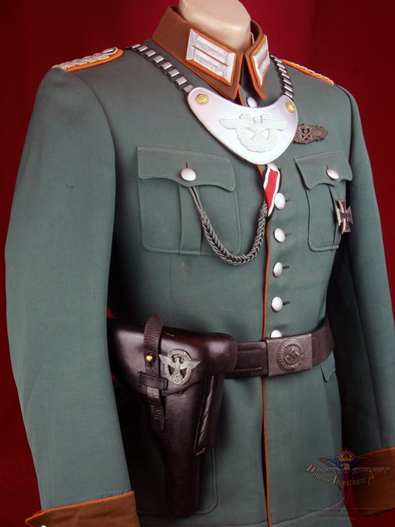 |
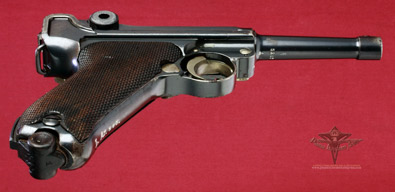 |
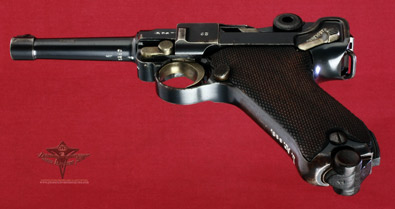 |
|
The barrel length is 4" (100mm) and is chambered for 9mm. The serial number appears on the front of the frame, on the left side of the receiver, on the side plate sear and trigger. This Luger is all matching including the magazines. This Luger bears a stock lug and a hold-open. The 1914 Model Luger is characterized by the short frame, the rear "V" cut fixed and front dovetailed sight and the frame with the stock lug. These series of Lugers were produced from 1914 until 1918 for the German Military. The thumb safety is marked "Gesichert" and when exposed (safety down) means safe. |
|
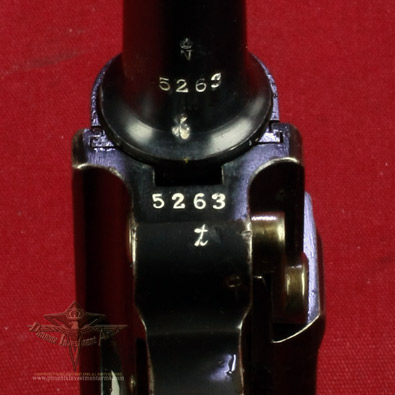 |
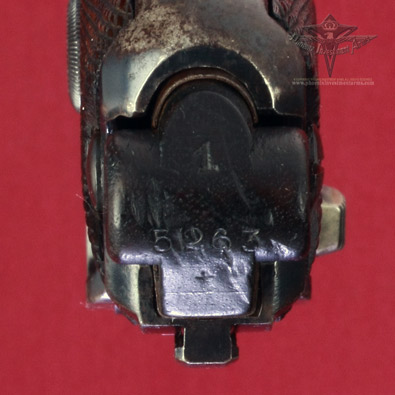 |
|
Serial number placement is in the military ("exposed") style. The serial number appears on the front of the frame, on the side of the locking bolt, on the trigger, on the bottom of the barrel, the side plate, the left side of the receiver, the safety bar, the sear bar, the rear connecting pin, and on the extractor. The frame is DWM built without the Mauser 2mm extension on the "wings" to protect the rear main axel pin when in full recoil. The extractor is marked "Geladen" on the left side and the safety is marked "Gesichert" with the safe position being downward. Below the loading tool is serial; numbered to the gun as are the majority of the police units. |
|
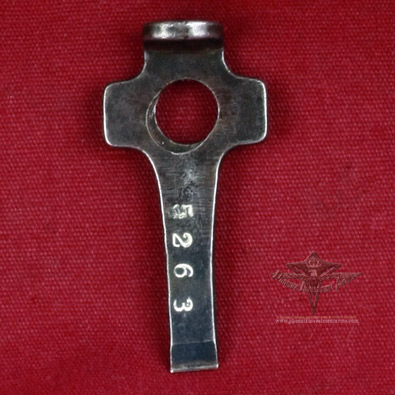 |
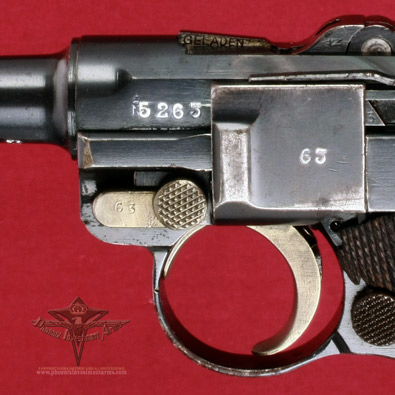 |
| Police Models generally had the serial number of the gun marked on the loading tool. Above Right: When the gun is loaded the extractor marked GELADEN (Loaded) is up giving the shooter both a visual and the ability to feel the raised extractor in darkness or when concentrating on the target. | |
|
|
|
|
|
|
|
SEAR SAFETY: During the 1920's it was determined German authorities that one could remove the side plate with the gun loaded, thereby exposing the sear, and by then pressing on the sear discharge the gun. In this case you can see the sear safety probably fully installed at the original time of the first re-work. This was the invention of Ludwig Schiwy, a gunsmith and the owner of F.W. Vandry & Company, Berlin. It consisted of a spring-steel bar on the top of the trigger plate which springs down into a recess in the sear bar, locking the mechanism, if the trigger plate was removed. |
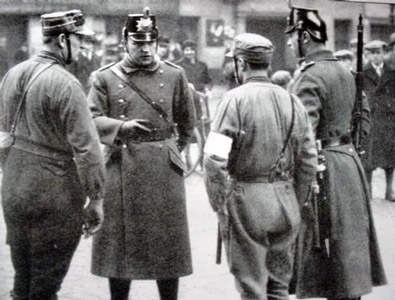 |
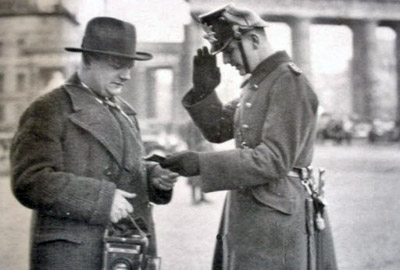 |
•Until
1933 each state in Germany had its own police force. By
1936 they had been centralised under Himmler as Chief of
Police.
The Landespolizei were the main law
enforcement agency of Germany.
In
Nazi Germany the police were allowed to arrest people on
suspicion that they were about to do wrong. This gave
the police huge powers. All local police units had to
draw up a list of people in their locality who might be
suspected of being "Enemies of the State". This list was
given to the Gestapo - the Secret Police.
The police were divided into the Ordnungspolizei (Orpo or regular police) and the Sicherheitspolizei (SiPo or security police), which had been established in June 1936.The Orpo assumed duties of regular uniformed law enforcement while the SiPo consisted of the secret state police (Geheime Staatspolizei or Gestapo) and criminal investigation police (Kriminalpolizei or Kripo). The Kriminalpolizei was a corps of professional detectives involved in fighting crime and the task of the Gestapo was combating espionage and political dissent. |
|
|
|
|
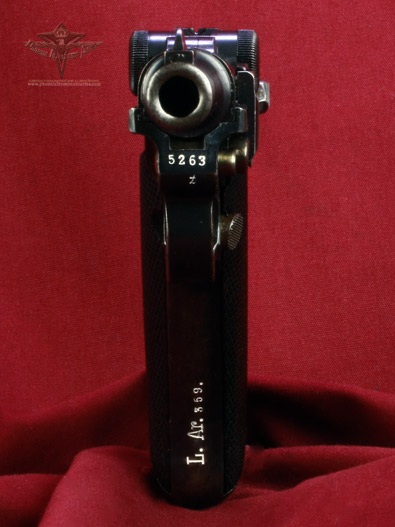 |
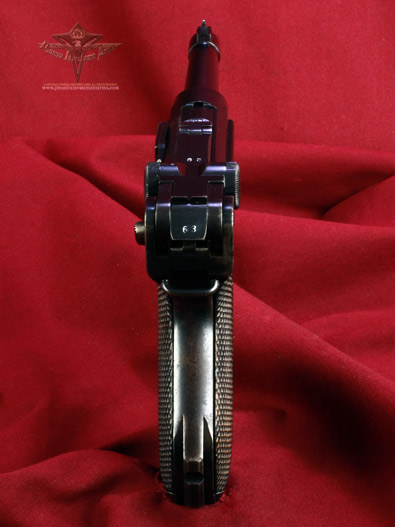 |
| The grips are walnut and match the gun. The magazine is the wrapped and crimped steel with the wooden bottom and is numbered in the police manner. the older wooden bottom magazines were the last of the DWM contract gun. | |
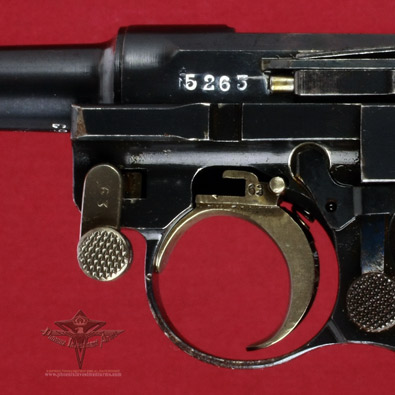 |
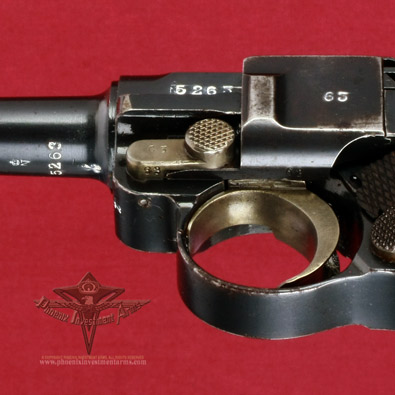 |
|
The extractor is marked "Geladen" on the left side and the safety is marked "Gesichert" with the safe position being downward. The proof marks are the amazing story of this guns. On the left is the frame and barrel matching serial numbers. Right: Above right of the trigger is the hole drilled in the frame for the magazine safety. This safety was not effective or popular and was routinely removed by the unit armorer. |
|
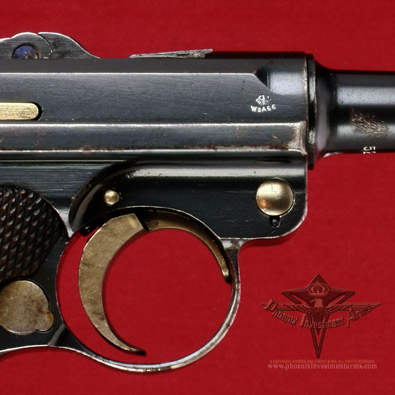 |
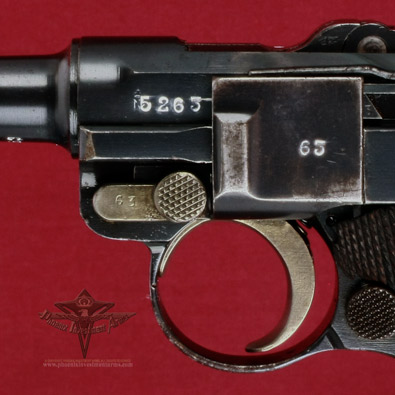 |
| No manufactures marks are found on this gun; on the right side is the Weimar Early Waffen Amt proof. All numbers are matching and the strawing is still decently showing. | |
|
|
|
|
Magazine Safety: The magazine safety consists of a "U" shaped leaf spring with two extensions, fitted into the left side of the frame under the grip. (Seen to the left with the hole drilled in the frame.) One of the extensions fits into the front and lodges behind the trigger while the other end fits through the frame into the magazine well. With the magazine in place the extension is pushed left and out of the path of the trigger. Removing the magazine allows the safety to move to the right so the bar moved behind the trigger and prevents it from being pulled. This was patented by Carl Walther in October 1932. |
|
|
|
| The double tabs have been removed and the single belt loop has been installed for this police gun, angled for police wear. | |
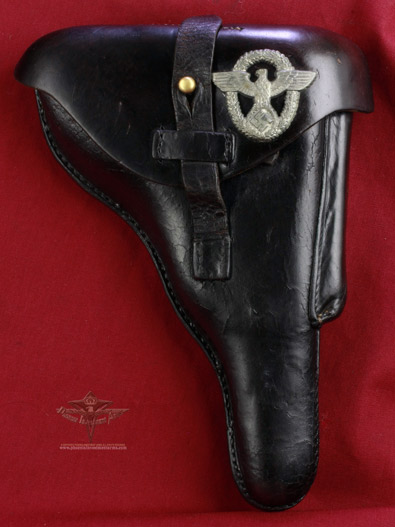 |
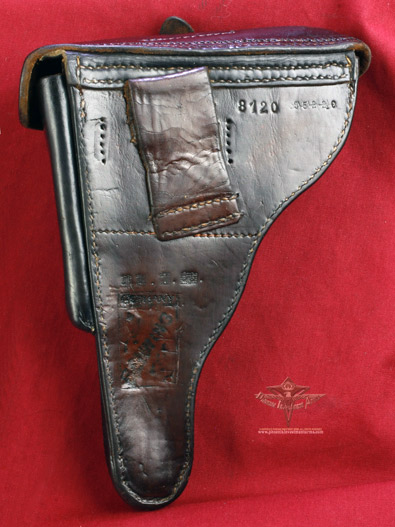 |
|
The front and back of the holster are still strong in the leather with everything functional and subtle. You can see it has been re-worked as starting in the early Weimar era and then utilized and re-stamped with Nazi numbers and code. A treasure trove of historical representation. |
|
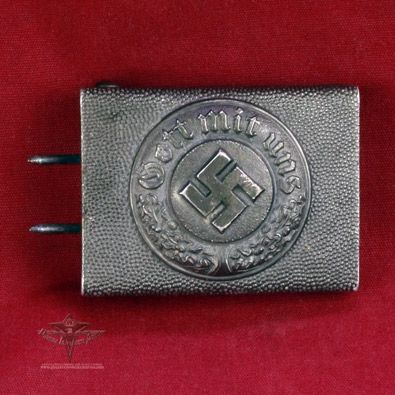 |
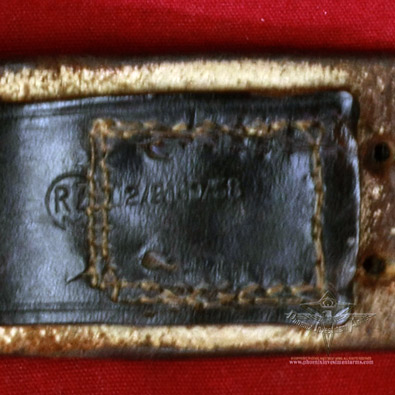 |
|
Above we can see the Nazi Police buckle with the pebbled backing, the swastika in the center framed by a wreath and Gott Mitt Uns (God with Us). On the right we see the bottom of the belt with the RZM marking from the manufacturer with their code. |
|
|
|
|
|
In 1936 the Landespolizei were merged into the Ordnungspolizei which assimilated the local police units into a national police force sometimes called the Grüne Poolizei (Green Police)
The Ordnungspolizei or Orpo was under the Ministry of the Interior Traditionally, law enforcement in Germany had been a state and local matter. In this role, Himmler was nominally subordinate to Interior Minister Wilhelm Frick. However, the decree effectively subordinated the police to the SS, Himmler gained authority as all of Germany's uniformed law enforcement agencies were amalgamated into the new Ordnungspolizei, whose main office became populated by officers of the SS. |
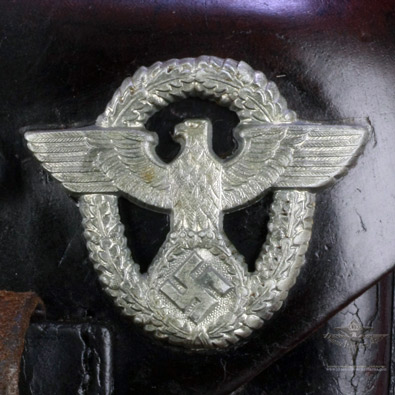 The Insignia of the Ordnungspolizei on the holster suggests this officer was from the Berlin detachment and a proud member of his unit. |
|
|
|
|
Starting in 1929 all Landjäger (Rural Constables) were to be re-armed with the P-08. This gun number 359 was assigned to Landjägerei Arnsberg. See Sturgess & Görtz Pistole Parabellum Chapter 21 page 535 for similar weapons described. Very rare police model. |
|
|
|
|
|
The gun is very clean showing slight holster wear on the muzzle, the side plate and front part of rails. This Police model is very unusual in that it has both the sear and magazine safety. These safeties were implemented for by directive for police units. The magazine safety's were mostly removed by unit armorers based on complaints and then slowly discontinued in the late 1930's. |
|
|
|
|
|
|
|
|
This gun bears a serial number "65" to the gun in response to the 1932 the Reichswehrministerium order that the rear connecting pin be serial numbered to the gun. be numbered so that they were not interchanged in cleaning. In full recoil with the heavy loads the Luger shoots a loose pin would have the edge flange chipped and required replacement. The straight back of the "ears" on the P-08 tell us that it was a DWM manufactured frame. There are two magazines in the rig, they are marked in the police fashion numbered 1 & 2 and are early DWM type magazines. |
|
|
|
|
|
|
|
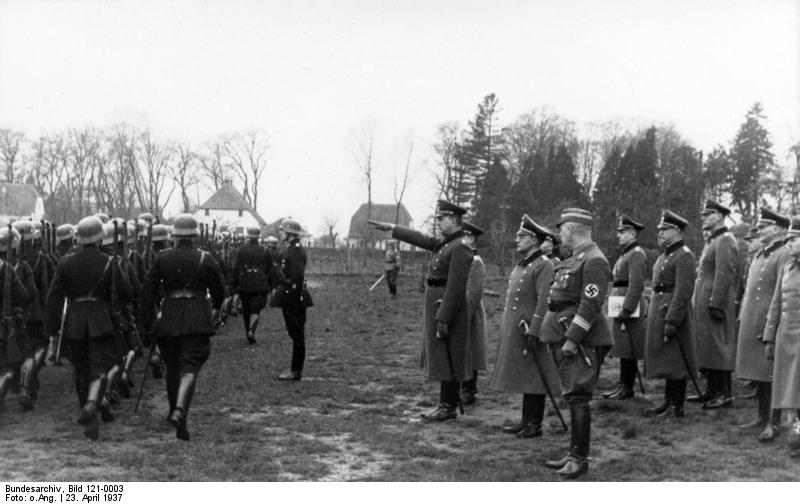 A parade of uniformed police in Bremen in 1937 (Note SA officer in front of reviewing commanders. |
|
|
|
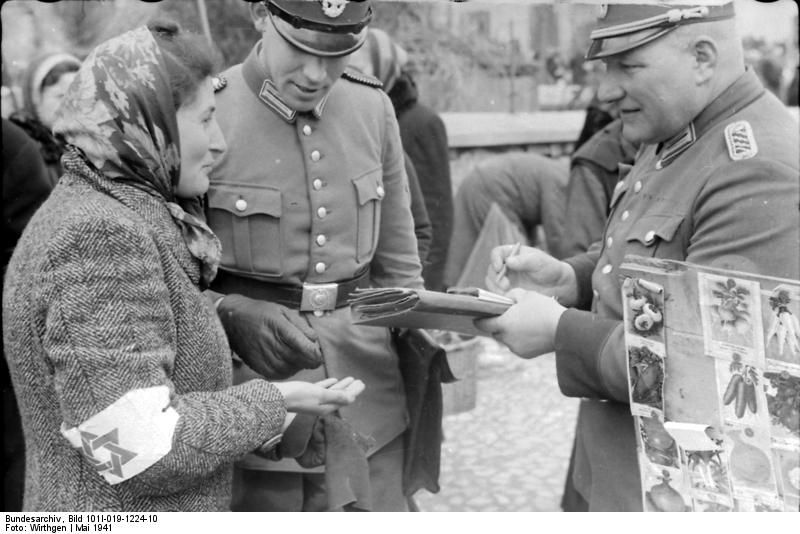 |
|
|
|
|
|
|
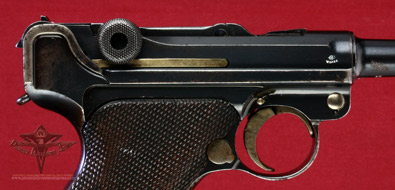 |
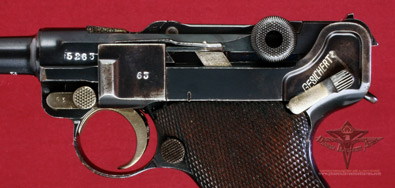 |
|
So now that we know where they came from and what the characteristics of the unmarked Parabellums were the term "Sneaks" seems to lose some of its meaning; they obviously were know to the Allied Commission because they were authorized for delivery in 1929 to the police units; they just came from a order to Morocco that weren't manufactured marked and decidedly not delivered. |
|
|
|
|
| It is entirely subjective to give any Luger a rating of excellent or fine, just as it is to declare it xx% blued or strawed. Few Lugers are out of the box new and these are premium priced. Bluing percentages is like Beauty, in the eye of the beholder. We strive to provide pictures so you can judge for yourself if the gun meets your criteria | |
|
|
|
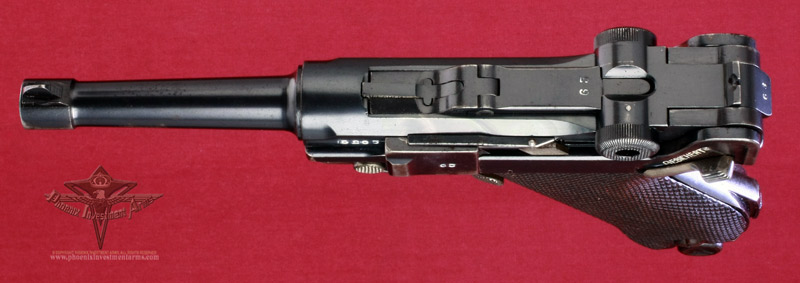 |
|
This rig is offered with the all matching unit marked Late DWM Police Luger, two matching magazines, a matching loading tool, a police holster and Nazi police belt and buckle. The Sneak Weimar/Nazi Police Luger is offered for [SOLD] over-the counter to the police collector. We reserve the right to withdraw any firearm from an auction site that is sold over the counter. Questions to: josef@phoenixinvestmentarms.com |
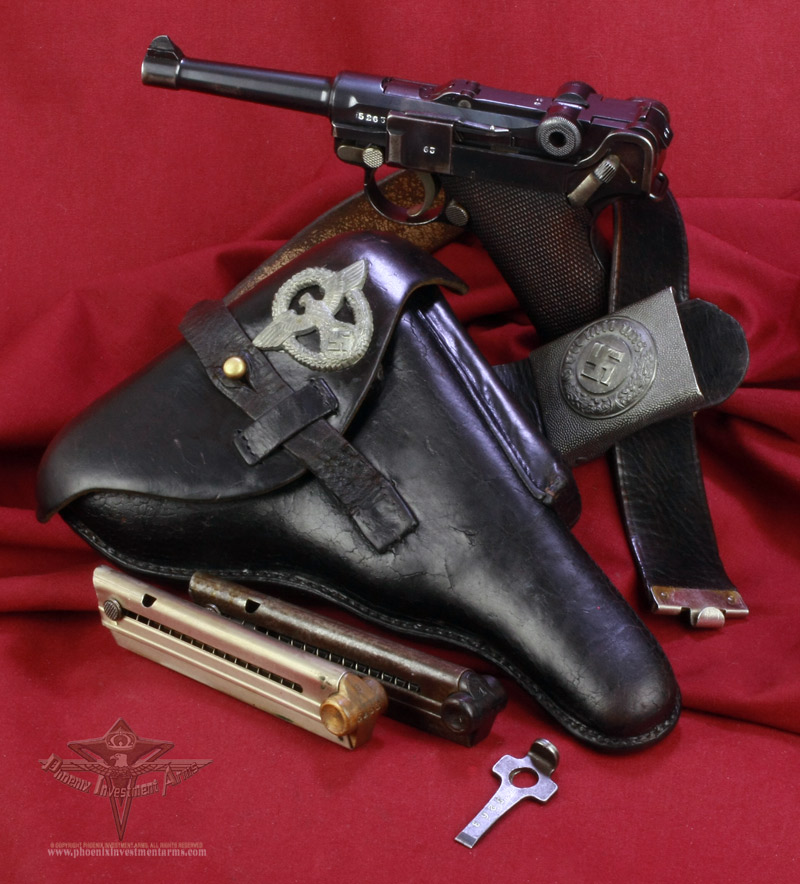 |
© Copyright 2001-2014 Phoenix Investment Arms Inc.
|
LAYAWAYS: Sometimes our "significant other" doesn't understand the beauty, craftsmanship and investment potential of one of these investor grade weapons. In these circumstances where discretion becomes the better part of valor we will accept layaways of up to one year with at least 20% down and some activity occurring monthly to insure that after one year the sale is completed. Cancellations of layaways forfeit 33% if done within two months, otherwise 100%. You can transfer a layaway to a consignment sale at any time. See "Legal" for exact terms. |
|
3 Day Return Policy We honor a three day return policy. We will answer any questions, send you any pictures, as detailed as you want, to insure that what we are showing you is what you want to see, before you buy it. See Legal. |
||
|
||
|
Over 35 Legendary Lugers, in multiple high-resolution shots depicting details you can study, over 90 pictures, close to 30 minutes of viewing time. Click below to see more. |